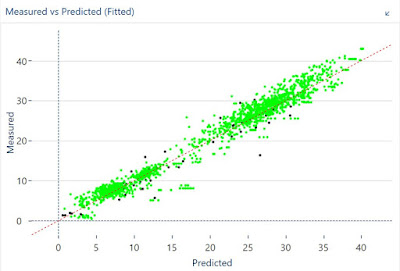One way to expand a calibration is with the option "Expand a product library with new spectra" included in the "Make and use scores" option of Win ISI.
We have a library file (cal file) with the samples we have use to develop a calibration. We have also the ".pca" files and ".lib" files which are giving us the GH and NH values.
Now we have new samples analyzed after installing this equation in routine, and we want to select the samples which can expand the calibration in order to make a more robust model. This selection is based on the NH distances, so the calibration will select empty spaces in the LIB file and will expand the PCs in other directions in the case we get new variability.
To expand the library we need the P and T matrices of the current library and the ".nir" file of the new spectra with the candidates to expand and fill the current database. We can stablish a certain cutoff for the NH limits, being 0.6 the default.
In this case of the total 46 samples 21 have a NH value higher than 0.600, so they are selected to expand the calibration. 5 samples are similar to the samples we have in the library we have use to develop the current calibration with their ".pca" and ".lib" files and these 5 samples have a "L" at the end. Finally 20 samples are similar to the selected ones, so it does not make sense to choose them, because they are redundant with the selected ones, this samples have an S at the end,
So we can send this samples to the lab to create a new cal file that we will merge with the current cal file to expand the calibration.



